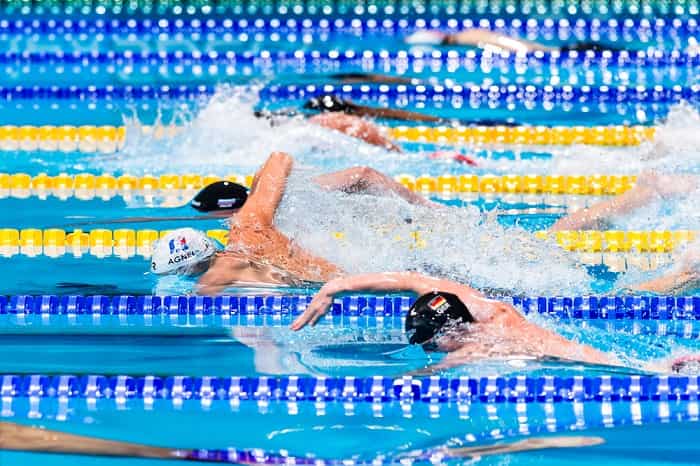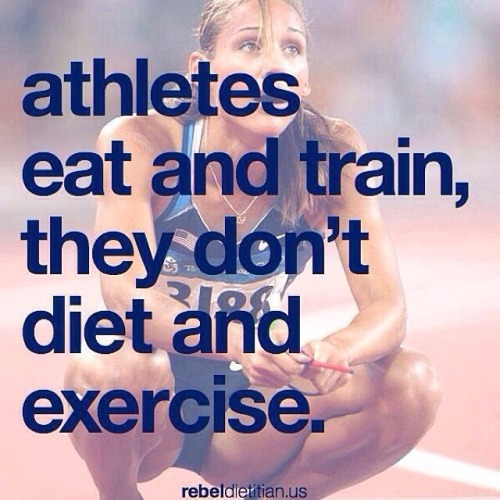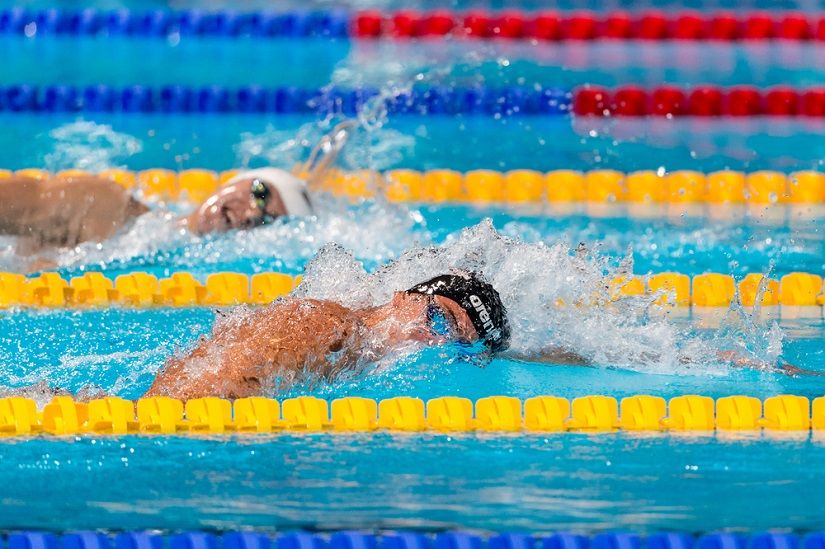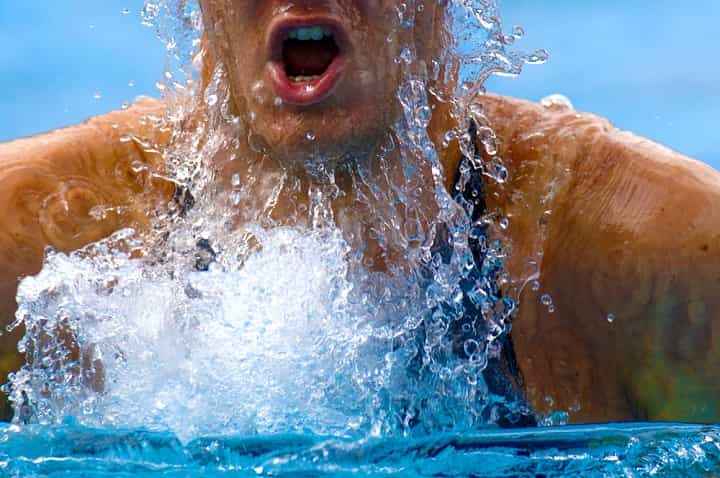by Olivier Poirier-Leroy of yourswimlog.com
Muscle cramps are a common condition experienced by competitive swimmers over the course of their swimming career. Here is what you need to know about preventing muscle cramps for swimmers.
They are the worst…
They jump up and bite you sometimes out of nowhere, leaving you helpless and gasping for air and your leg as you hang off of the side of the pool or the lane rope.
The ones in the toes and heel aren’t so bad, but a calf or hamstring cramp?
Sweet… chlorinated… molasses.
After gingerly stretching it out on the pool deck you slide back into the water and do the rest of your workout at half speed for fear of firing off another wave of paralyzing muscle contractions.
During my age group days, coach would always emphasize drinking lots of water (even though most swimmers don’t always understand the need to do so as they don’t notice how much they are sweating while in the water), while making sure that we ate lots of bananas in order to maintain potassium levels.
Gotta keep them electrolytes and nutrients up!
But with a handful of bananas under my belt already that day, and half a 4L of water already down, something always seemed to be missing in the explanation that it was just dehydration.
The reality is…
We don’t know for sure what it is that causes muscle cramps.
But we have a pretty good idea.

The Reasons Why Swimmers Cramp Up
The reality is that science hasn’t quite figured out the exact reasons for why muscle cramps occur. Although they are very common, not just with swimmers but across every other sport as well, they are poorly understood, and theories for why they happen are from anecdotal experience.
From a mountain of studies that have sought to figure out the root cause of muscle cramps, there are two theories that are discussed most frequently:
1. Dehydration
Coaches are always on their swimmers to drink more water. And for good reason—even just being dehydrated by a couple percentage points can lead to a swift drop in performance.
Muscle cramps are thought to happen because athletes, while performing peak intensity exercise, are losing more water than they ingesting, and thereby sensitizing nerves in your muscles.
Here is a nice sciencey definition of what happens next:
The resulting contracture of the interstitial space increases the mechanical pressure on select motor nerve endings and finally results in exercise-associated muscle cramping.
As a result, it’s thought that athletes and those who work in hot and humid conditions, and are prone to sweat lots and thereby lose a whole bunch of electrolytes, are more likely to incur cramping:
- Researchers found that athletes who were playing and working out in warmer environmental conditions were more likely to cramp up, while another study found that athletes who sweat more cramped up more often.
- A national level tennis player who was having trouble finishing matches due to cramps—he was also sweating 2.5L per hour— was able to successfully eliminate them by upping his daily sodium intake.
But what about those times that were fully hydrated, in a cool swimming pool, and you still felt your hamstring seize up on you?
And if it were as simple as fluid replacement, it doesn’t explain that 69% of athletes in this study who took a carbohydrate-fluid that precisely matched sweat loss still experienced muscle cramps.
Well, there’s a theory for that too.
2. Muscle Fatigue
It wasn’t too long ago that I did a heavy session in the gym doing max weight for numerous sets of back squats. In my swim, which immediately followed the lifting, my legs were perpetually on the verge of cramping up.
Each push-off I could feel some twitchiness in my quads and hamstrings, and for the duration of my swim I took it easy on the walls. (It also meant not kicking and swimming with fins. Boo-urns.)
In other words, the muscles in my legs that I had been using in the gym kept firing and contracting.
Which leads us into the second theory–cramps happen because of straight-up muscle fatigue.
Numerous studies have shown cramping to happen towards the end of competition when the muscle is already shortened and tired.
Which, if you have experienced something similar to my squat example above, makes intuitive sense.
After all, you probably also notice that you cramp up more often at the beginning of the season, after a long layoff, or during particularly trying stretches of training when you are either not in great shape, or fatigued.
How to Prevent & Deal with Muscle Cramps
Because there is no generally agreed upon source of muscle cramps, there is no singular course of treatment and prevention.
Treatments such as cryotherapy, massage, pickle juice, sports drinks, and more all lack experimental research.
1. Stay hydrated.
Even though there is a lack of direct evidence of cramps to dehydration, there is—as mentioned previously—a drop in performance that happens when swimmers aren’t hydrated.
Don’t just wait until you get to practice to start crushing water. Swimmers who drink a liter of water 60 minutes or so prior to practice or competition can be assured that the fluids will be fully absorbed and available.
2. Add salt to your water jug.
If you are one of those super sweaty athletes (and I am one too, no judgement here), the National Athletic Trainer’s Association recommends you add 0.3 to 0.7g of salt to your water jug in order to help you avoid cramping up.
3. Stretch it out.
Gentle stretching on the affected area can help to soothe they soreness and immediate pain. Soreness can last for a few minutes or up to a few days. Light passive stretching makes it go away faster.
4. Dial up your intensity accordingly.
My mistake with my squat-swim combo was going heavy on my legs after having taken a little sabbatical from the gym. Do I regret that workout? Not necessarily—but knowing that it would ruin my swim afterwards would I have done it with the same intensity? Probably not.
Cramps tend to happen when we are pushing ourselves harder than normal, or when we are going too hard compared to our training experience. Which isn’t necessarily the worst thing for an elite athlete who is constantly trying to probe the reaches of their limits, but perhaps kind of pointless for someone who is simply going to the pool to get into better shape.
The Takeaway
There’s no total guarantee that if you drink lots of water and escalate your training at a reasonable pace that you will never experience a muscle cramp again.
However, if you do those two things you will cut down on them significantly, and at the very least, will reap the performance benefits that come with being a full hydrated swimmer.
As for me, I am back off to the squat rack to give that thing another go.
 What makes an athlete elite? I haven’t met an athlete yet that doesn’t want to be at the top of their game, the tip of the spear, the best of the best. So, how do you get there? There are many components to success in sport. We are all familiar with attributes like hard work, determination, commitment, dedication and focus. But what else could help take your performance to another level? The elite athlete is always seeking new ways to perfect and grow in sport and improve his/her performance.
What makes an athlete elite? I haven’t met an athlete yet that doesn’t want to be at the top of their game, the tip of the spear, the best of the best. So, how do you get there? There are many components to success in sport. We are all familiar with attributes like hard work, determination, commitment, dedication and focus. But what else could help take your performance to another level? The elite athlete is always seeking new ways to perfect and grow in sport and improve his/her performance. After completing her undergraduate degree in Communications and Spanish from Arizona State University she pursued holistic nutrition education at Southwest Institute of Healing Arts in Tempe, Arizona. Anita is a Certified Holistic Nutrition Specialist, Certified Life Coach and accomplished motivational speaker. Anita is also an elite member of the International Swimming Hall of Fame.
After completing her undergraduate degree in Communications and Spanish from Arizona State University she pursued holistic nutrition education at Southwest Institute of Healing Arts in Tempe, Arizona. Anita is a Certified Holistic Nutrition Specialist, Certified Life Coach and accomplished motivational speaker. Anita is also an elite member of the International Swimming Hall of Fame.
